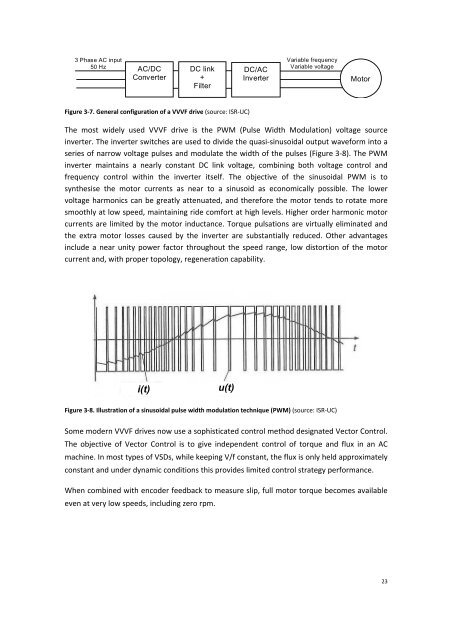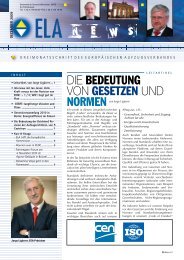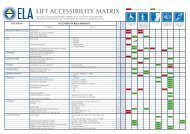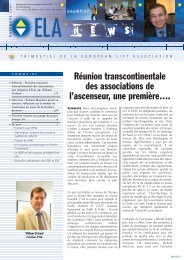WP6-Brochure-E4 brochure - ELA European Lift Association.
WP6-Brochure-E4 brochure - ELA European Lift Association.
WP6-Brochure-E4 brochure - ELA European Lift Association.
Create successful ePaper yourself
Turn your PDF publications into a flip-book with our unique Google optimized e-Paper software.
3 Phase AC input<br />
50 Hz<br />
AC/DC<br />
Converter<br />
DC link<br />
+<br />
Filter<br />
DC/AC<br />
Inverter<br />
Variable frequency<br />
Variable voltage<br />
Motor<br />
Figure 3‐7. General configuration of a VVVF drive (source: ISR‐UC)<br />
The most widely used VVVF drive is the PWM (Pulse Width Modulation) voltage source<br />
inverter. The inverter switches are used to divide the quasi‐sinusoidal output waveform into a<br />
series of narrow voltage pulses and modulate the width of the pulses (Figure 3‐8). The PWM<br />
inverter maintains a nearly constant DC link voltage, combining both voltage control and<br />
frequency control within the inverter itself. The objective of the sinusoidal PWM is to<br />
synthesise the motor currents as near to a sinusoid as economically possible. The lower<br />
voltage harmonics can be greatly attenuated, and therefore the motor tends to rotate more<br />
smoothly at low speed, maintaining ride comfort at high levels. Higher order harmonic motor<br />
currents are limited by the motor inductance. Torque pulsations are virtually eliminated and<br />
the extra motor losses caused by the inverter are substantially reduced. Other advantages<br />
include a near unity power factor throughout the speed range, low distortion of the motor<br />
current and, with proper topology, regeneration capability.<br />
i(t)<br />
u(t)<br />
Figure 3‐8. Illustration of a sinusoidal pulse width modulation technique (PWM) (source: ISR‐UC)<br />
Some modern VVVF drives now use a sophisticated control method designated Vector Control.<br />
The objective of Vector Control is to give independent control of torque and flux in an AC<br />
machine. In most types of VSDs, while keeping V/f constant, the flux is only held approximately<br />
constant and under dynamic conditions this provides limited control strategy performance.<br />
When combined with encoder feedback to measure slip, full motor torque becomes available<br />
even at very low speeds, including zero rpm.<br />
23

















